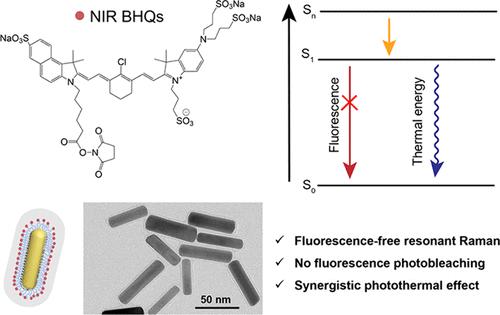Nonfluorescent Near-Infrared Surface-Enhanced Resonance Raman Nanoprobes with Ultrahigh Brightness and Synergistic Photothermal Effect
IF 8.2
2区 材料科学
Q1 MATERIALS SCIENCE, MULTIDISCIPLINARY
引用次数: 0
Abstract
Near-infrared (NIR) surface-enhanced resonance Raman (SERRS) nanoprobes have found wide applications in biomedicine; however, almost all of these nanoprobes are fluorescent because the resonant Raman dyes used cannot be fully quenched onto the underlying plasmonic nanoparticles. Therefore, suppressing the fluorescence backgrounds in resonant Raman spectroscopy imaging is extremely important. In this work, we use a black hole quencher, IQ1, as a Raman dye to develop absolutely nonfluorescent NIR resonant SERRS NPs. Ultrafast spectroscopy clarifies that the nonfluorescent mechanism of the dyes is attributed to the ultrafast internal conversion at the subpicosecond scale, which quenches the fluorescence of excited states. The resultant nanoprobes exhibit zero fluorescent background, femtomolar-level sensitivity (100 fM) as well as superb photostability (τ = 10006 s) without fluorescence photobleaching, outperforming that of fluorescent counterparts. More importantly, the SERRS NPs show a synergistic photothermal effect originating from the dye molecule-plasmon interactions, achieving a high photothermal conversion efficiency of 64.94%. Featuring these excellent properties, these SERRS NPs allow for longitudinally photostable cellular imaging and enhanced photothermal elimination of cancer cells. To the best of our knowledge, this is the first example of absolutely nonfluorescent NIR SERRS NPs, opening up promising applications for improved phototheranostics.

具有超高亮度和协同光热效应的非荧光近红外表面增强共振拉曼纳米探针
近红外(NIR)表面增强共振拉曼(SERRS)纳米探针已在生物医学中得到广泛应用;然而,几乎所有这些纳米探针都是荧光的,因为所使用的共振拉曼染料不能完全淬灭在底层的等离子纳米粒子上。因此,抑制共振拉曼光谱成像中的荧光背景极为重要。在这项工作中,我们使用黑洞淬灭剂 IQ1 作为拉曼染料,开发出绝对无荧光的近红外共振 SERRS NPs。超快光谱分析表明,染料的无荧光机制归因于亚皮秒尺度的超快内部转换,这种转换淬灭了激发态的荧光。由此产生的纳米探针具有零荧光背景、飞摩尔级灵敏度(100 fM)以及超强的光稳定性(τ = 10006 s),不会产生荧光光漂白,性能优于荧光探针。更重要的是,SERRS NPs 显示出染料分子与等离子体相互作用产生的协同光热效应,实现了 64.94% 的高光热转化效率。这些 SERRS NPs 具有这些优异的特性,可以进行纵向光稳定细胞成像,并增强消除癌细胞的光热作用。据我们所知,这是第一例绝对无荧光的近红外 SERRS NPs,为改进光热疗法开辟了广阔的应用前景。
本文章由计算机程序翻译,如有差异,请以英文原文为准。
求助全文
约1分钟内获得全文
求助全文
来源期刊

ACS Applied Materials & Interfaces
工程技术-材料科学:综合
CiteScore
16.00
自引率
6.30%
发文量
4978
审稿时长
1.8 months
期刊介绍:
ACS Applied Materials & Interfaces is a leading interdisciplinary journal that brings together chemists, engineers, physicists, and biologists to explore the development and utilization of newly-discovered materials and interfacial processes for specific applications. Our journal has experienced remarkable growth since its establishment in 2009, both in terms of the number of articles published and the impact of the research showcased. We are proud to foster a truly global community, with the majority of published articles originating from outside the United States, reflecting the rapid growth of applied research worldwide.
文献相关原料
公司名称
产品信息
索莱宝
paraformaldehyde
索莱宝
PBS
索莱宝
paraformaldehyde
索莱宝
PBS
索莱宝
Paraformaldehyde
索莱宝
PBS
阿拉丁
mercaptoethylamine
阿拉丁
Dopamine hydrochloride (DA)
阿拉丁
Mercaptoethylamine
阿拉丁
Dopamine hydrochloride (DA)
Sigma
sodium citrate
Sigma
sodium borohydride (NaBH4)
Sigma
Cetyltrimethylammonium bromide (CTAB)
 求助内容:
求助内容: 应助结果提醒方式:
应助结果提醒方式:


